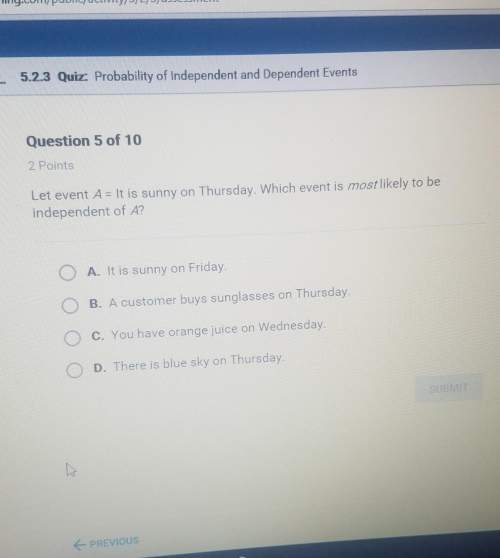
Mathematics, 16.02.2021 19:00, kimlyn58p0wyn0
A tile is 4 inches long.
If 4 tiles are placed sided by side, what would be the approximate total length in centimeters? (1 in 2.54 cm)
A
10 cm
B
16 cm
с
32 cm
D
40 cm

Answers: 1
Other questions on the subject: Mathematics

Mathematics, 21.06.2019 14:30, TheCampingStone
The sum of two numbers is 58. the first number is 8 less than half the second number. let c represent the first number. let drepresent the second number. which statements about solving for the two numbers are true? check all that apply. the equation  represents the sum of the two numbers. the equation  represents the sentence “the first number is 8 less than half the second number.”the equation  represents the relationship between the two numbers. the equation  represents the sum of the two numbers. the number d is 14.the number c is 44.the number c is 14.the number d is 44.
Answers: 1


Mathematics, 21.06.2019 17:00, casting479
Ajar of gumballs contains 4 reds, 2 greens, and 6 blues. what is the probability of getting two blues in a row without replacement?
Answers: 1

Mathematics, 21.06.2019 17:00, SillyEve
In tossing one coin 10 times, what are your chances for tossing a head? a tail? 2. in tossing one coin 100 times, what are your chances for tossing a head? a tail? 3. in tossing one coin 200 times, what are your chances for tossing a head? a tail? deviation = ((absolute value of the difference between expected heads and observed heads) + (absolute value of the difference between expected tails and observed tails)) divided by total number of tosses. this value should always be positive. 4. what is the deviation for 10 tosses? 5. what is the deviation for the 100 tosses? 6. what is the deviation for 200 tosses? 7. how does increasing the total number of coin tosses from 10 to 100 affect the deviation? 8. how does increasing the total number of tosses from 100 to 200 affect the deviation? 9. what two important probability principles were established in this exercise? 10. the percent of occurrence is the obtained results divided by the total tosses and multiplied by 100%. toss the coins 100 times and record your results. calculate the percent occurrence for each combination. percent head-head occurrence: percent tail-tail occurrence: percent head-tail occurrence:
Answers: 3
Do you know the correct answer?
A tile is 4 inches long.
If 4 tiles are placed sided by side, what would be the approximate total l...
Questions in other subjects:


Chemistry, 28.04.2021 01:50

Mathematics, 28.04.2021 01:50

Biology, 28.04.2021 01:50


Mathematics, 28.04.2021 01:50

Medicine, 28.04.2021 01:50


Mathematics, 28.04.2021 01:50







